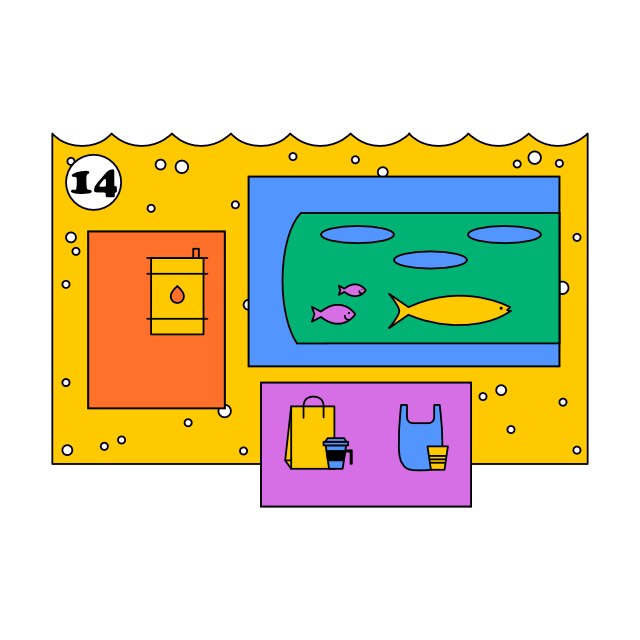SDG 14Life below water
How to protect the seas and oceans and the life that is (for now) in them?
Overview
Humanity “enriches” the ocean with more than 8 million tonnes of plastics every year. This releases around 50 trillion microparticles which are currently harming more than 800 animal and plant species. If we continue to discard single-use plastic at the current rate,1 there will be more plastics than fish in the ocean by 2050. In addition to plastic waste, seas are polluted by industrial and agricultural chemicals, oil waste and spills as well as biological threats such as algae overgrowth. We are exposed to all these toxins on a daily basis, especially when eating seafood.
Coral reefs are dying, oceans are acidifying, and biodiversity is disappearing. Unless there is a fundamental change, more than half of marine species will be threatened with extinction by 2100, says the UN.2
According to a recent study by an international team of scientists, ocean pollution is a growing global problem that scientists are only beginning to understand. Change requires immediate action.3
Solution and Key Innovations
In February 2022, the President of the European Commission announced three key initiatives for cooperation to preserve and revive the oceans: an international coalition to protect biodiversity on the high seas, a computing project allowing researchers to digitally stimulate the world’s oceans, and the EU’s research mission to restore our oceans and waters by 2030.4
Simultaneously, water purification and research technologies that might provide a way to protect the oceans are gaining importance. In 2018, Dutch scientists offered a very effective way of cleaning sea and river surfaces. It was Boyan Slat, 20 years old at the time, who came up with The Ocean Cleanup. The technology uses floating barriers pulled by ships to collect waste into nets. Once on land, the waste is recycled. In 2022, scientists and fishermen from New Zealand came up with Precision Seafood Harvesting, a system that uses special trawls to identify and catch specific fish species as opposed to traditional nets that also trap fish that do not survive the hunt or are thrown back due to not meeting the requirements.
In the future, oil and chemical spills could be quickly addressed by technologies such as the Oleo sponge developed by U.S. scientists at the Argonne National Laboratory. The sponge, similar to the one used for cleaning the dishes, can soak up oil spills as well as trap clouds of oil particles under the water. The trapped oil can be recycled. Another option is the magnetic soap developed by researchers at the University of Bristol. It consists of soluble iron-rich salts that react to magnetic fields when placed in a solution. Seaswarm, invented by the American MIT Senseable city lab, uses a conveyor belt made of a thin nano-network which attracts oil and repels water. The system is powered by photovoltaic cells and is GPS controlled.
Ocean pollution, however, poses a more general challenge, too. People should drastically eliminate the burning of fossil fuels and a ban on single-use plastics is on the table. The monitoring of coastal pollution and the expansion of protected marine areas can conserve crucial ecosystems, vulnerable fish stocks and improve the environment – which has a major impact on human health.
Key Questions
- Can we save the oceans and their ecosystems?
- How can humanity be persuaded to behave in an environmentally sustainable way towards the seas and oceans?
- How fast can we reduce carbon dioxide emissions?
- Can we protect coastal countries from rising sea levels?
Key Words
Ocean pollution, marine ecosystems, technology, sea level rise, oil spill
Interesting Resources
- The U.S. National Oceanic and Atmospheric Administration aims to understand and predict changes in climate, weather, oceans and coasts, share this knowledge and information with others, and to protect and manage coastal and marine ecosystems and resources
- Researchers from the Czech research institute CEITEC are working on microrobots that can break down microplastics in the oceans
- The scientists from The Royal Netherlands for Sea Research suggest building two huge European dams between Scotland and Norway and between England and France which aim to protect the land from the rising sea level
- The Slovak architect Lenka Petráková from the London Zaha Hadid Architects Studio came up with the 8th Continent concept – a floating station designed to be self-sufficient and sustainable while collecting ocean waste
